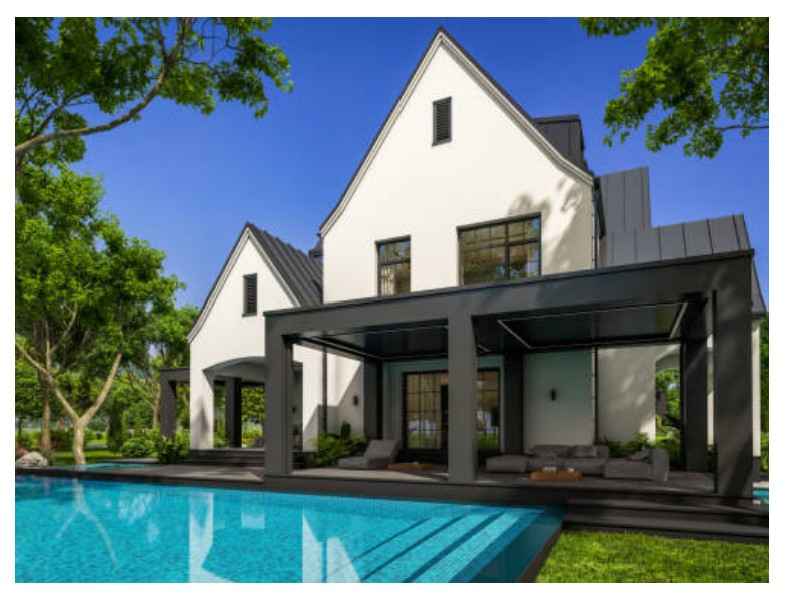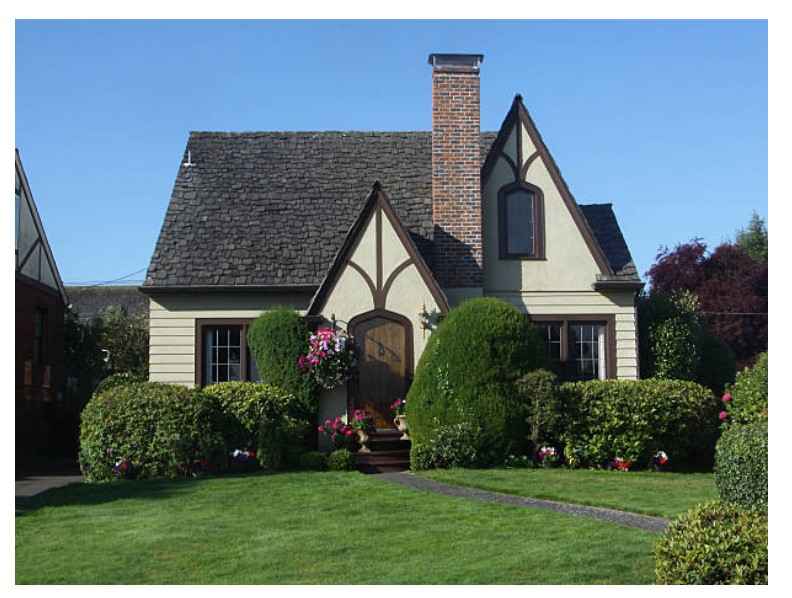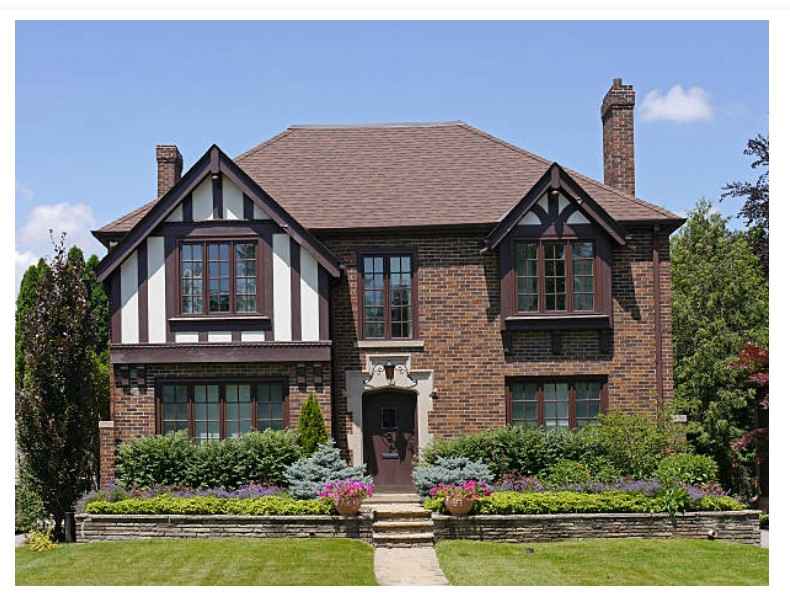Tudor Style House is a traditional architectural style that originated in England.
Tudor-style buildings are distinguished by their half-timbered external walls, steeply pitched roofs, and ornamental stone or brickwork; they radiate a charm that distinguishes them from other architectural forms.
If you possess a Tudor Style House and wish to update its appearance, several options exist.
This post will go through some of the most effective techniques to transform the appearance of a Tudor Style House.
What Is A Tudor Style House?
Homes built in the Tudor style may be traced back to the late 15th to the early 17th century in England. These houses are easily recognizable because of their distinctive high rooflines, ornamental half-timbering, and central chimneys.
The American love affair with Tudor architecture began in the early 20th century and showed no signs of abating. Usually brick or stucco, with an ornate wood frame painted differently than the rest of the façade.
The steeply slanted roofs and many gables and dormers characteristic of English Tudor house architecture are instantly recognizable. Slate and tile are common materials for roofing because of their durability and ability to shed water.
Half-timbering, or decoratively showing the wooden structure of the building on the external walls, is another defining feature of Tudor-style dwellings. After the design is finalized, plaster or brick covers the exposed wood.
How To Change The Look Of A Tudor-Style House?
Add New Siding
Changing the siding on a Tudor home is a simple approach to updating the exterior’s appearance. Half-timbered walls are characteristic of traditional Tudor architecture, often covered with stucco or brick.
But, if you want to give your modern Tudor-style house makeover, you may use various materials, such as vinyl, wood, or fibre cement. Vinyl siding is widely used since it is inexpensive and requires little upkeep.
The wide range of colours and designs makes it easy to choose something that works with the aesthetic of your Tudor-style home.
Tudor-style homes benefit greatly from either stone or wood siding. It may be stained or painted to complement your home’s exterior colour scheme and provide warmth and texture.
Yet wood siding needs regular upkeep to avoid decay and insect damage. Newer options like fibre cement siding may mimic the appearance of wood without the hassle.
It is a long-lasting material for Tudor-style homes since it does not burn, attract insects, or deteriorate.

Update The Windows
One of the best ways to make a modern Tudor-style house is to replace the original windows with new ones. Small, diamond-shaped windows are a signature feature of classic Tudor architecture.
However, modern windows come in a wide range of forms and designs, so you may choose one that works exceptionally well with your Tudor-style home’s design.
Double-hung windows are often installed to maintain the traditional aesthetic of a Tudor-style home. They’re simple to use and great for the environment.
Another fantastic window form for Tudor-style homes is the casement window. These windows are great for homeowners who prefer a more open feel and more natural light than what double-hung windows provide.
Update The Roof
Changing the roof may significantly influence the visual appeal of your Tudor-style home since it is such a prominent feature of the type.
Tudor-style homes are easily recognized by their steeply sloping roofs covered in hardwood shingles or tiles. You may modern Tudor-style houses by using alternative roofing materials.
Asphalt shingles are often utilized in Tudor-style houses due to their cheap cost and ease of installation. You may select the ideal fit for the aesthetic of your Tudor-style house from various colours and styles since they are available.
Metal roofs look amazing on Tudor-style houses as well. They complement the house’s traditional architecture and are long-lasting while offering a modern look.
Add Decorative Accents
Another great way to change the look of a Tudor-style house is by using decorative accents. The windows, entrances, and chimneys of Tudor-style structures often include stone or brickwork.
Whatever the case, there are many various decorative accents you may add to your Tudor-style house to enhance its appearance.
Shutters are a typical window accessory. You may choose from various shutter styles and hues to find the ideal match for your Tudor-style house.
Installing decorative moulding around wall openings like windows and doors is one approach. You may buy this moulding in various materials, such as wood, vinyl, and others, and paint or stain it to match the outside of your Tudor-style house.
The outside of an English Tudor house may be modernized by installing a new front door. An upgraded front door that works with the design of your Tudor-style home will do wonders for the property’s first impression.
Wood, fibreglass, or steel entry doors are all viable options, and each may be further personalized by adding glass inserts and sidelights.
Improving your Tudor’s curb appeal is as simple as installing outside lights. Besides serving as a security measure, outdoor lighting may be employed to draw attention to your home’s design.
Outdoor lighting choices range from wall sconces and post lights to landscape illumination.

Landscaping
Landscape design may dramatically affect the visual appeal of an English Tudor house. A property with a Tudor aesthetic might benefit from a landscape that is both well-maintained and tastefully arranged.
Putting in new plants and flowers is an easy way to refresh the look of the landscape around your Tudor home.
Select plants that can thrive in your area’s typical temperatures and look well in your home’s design. Create a rich and colourful environment by planting a variety of shrubs, perennials, and annuals.
Instead, you might install hardscaping elements like patios, retaining walls, and pathways. Combined with your Tudor home’s classic design, these landscaping elements may create an inviting outdoor living area.
Tudor-Style House: Pros and Cons

Every house has advantages and disadvantages, and it all depends on what you need as a homeowner. To decide whether a Tudor-style home is the best choice for your home ownership objectives, learn about some of these homes’ main Pros and Cons.
Pros of a Tudor-Style House
- Historical background: The age and history of a Tudor-style home are two of its main appeals. These houses stand out from the competition because of their distinctive features, unique characteristics, and even secret chambers.
- Structural quality: Some of the characteristics of Tudor design that make these houses constructed to survive are solid masonry, stone chimneys, and plaster walls. Due to the sturdy construction of Tudor-style homes, you may not need to worry as much about particular aspects that require updating.
- Asymmetrical design: Tudor Revival homes are often square or rectangular, but their floor plans are asymmetrical. It implies that the two sides of the home are entirely distinct. Homeowners are given greater creative flexibility because of this distinctive feature.
- Dimensions: Tudors often have more square footage than the average single-family home, which might be a great bonus for people seeking a spacious home.
Cons of a Tudor-Style House
- Roofing issues: Tudor homes generally have durable slate roofs. Nevertheless, the many gables and dormers might provide issues with the valley flashing, where two roof sections converge. Valley flashing enables optimum runoff of precipitation. Yet you can see more leaks because of the elaborate roof detailing of Tudor homes.
- Age: Older houses can significantly have problems if they haven’t been upgraded lately. You could need more care and improvements than you would in a recently built home since many Tudor-style homes are close to a century old.
- Building materials: Due to the elaborate detailing, exterior design, and internal layout of Tudor homes, the construction materials required to update its characteristics adequately may increase the cost of repairs. If you want to return your Tudor-style home to its former splendour, you must hire someone with expertise working with older houses.
- Price: Tudor homes tend to be bigger and made with costly materials. They could thus cost more than other housing designs. However, you may still discover a smaller Tudor home that is within your price range.
FAQs-
Do people still build Tudor houses nowadays?
Absolutely, Tudor architecture is still being built today due to its widespread popularity. On the other hand, contemporary Tudor-style houses often modernize the appearance and feel of the style with contemporary design features and building materials.
Why are Tudor houses so expensive?
Due to their distinctiveness, luxury, and historical significance, Tudor homes are pricey. They are more expensive to build and maintain because they often need specialised labour and materials.
What are the disadvantages of Tudor homes?
Tudor-style mansions are hard to maintain owing to their complicated construction. Another negative is smaller windows and darker rooms.
Why do people like Tudor houses?
People like Tudor homes because they distinctively combine Middle Ages and Renaissance architectural styles. Many people admire the lovely, classic appearance that their steeply pitched roofs, ornamental half-timbering, and conspicuous chimneys provide houses.
What is the most famous Tudor house?
Perhaps the most well-known Tudor residence is London, England’s Hampton Court Palace. In the early 1600s, it was first constructed for Cardinal Wolsey. Later on, King Henry VIII improved it and made additions.
How can I decorate a Tudor-style house?
You can make your Tudor-style house more decorative by adding stylish window accessories, like shutters. Moreover, you may also use designable molding from various materials like vinyl, wood, etc. You can also use interesting paint to give a unique look to your house.
Conclusion:
A home designed in the Tudor style may undergo several transformations. Improving your home’s exterior appeal is as simple as updating the siding, windows, roof, ornamental accents, and landscaping.
If you own a Tudor-style home and are thinking about doing some renovations, it’s essential to find solutions that work with the existing architecture while also satisfying your aesthetic preferences and financial constraints.
Your Tudor-style home may be renovated into a modern, stylish residence with just a little forethought and imagination.
